
One of the fascinating things I’ve learned studying natural healing and herbalism for over 40 years has been the powerful connections between thoughts and emotions and physical health problems. As I’ve pointed out in many of the articles I’ve written, there are interesting parallels between the uses of certain herbs as physical remedies and their use as flower essences for emotional healing.
I first learned about these connections, reading about the signatures of black cohosh and uses as an emotional healing agent, in Matthew Wood’s Seven Herbs: Plants as Teachers. Black cohosh is best known as a female remedy with a natural estrogenic effect. It has helped many women going through menopause, reducing symptoms like hot flashes and night sweats, but it also has other well-known uses that make it useful for both women and men.
The Energetics of Black Cohosh
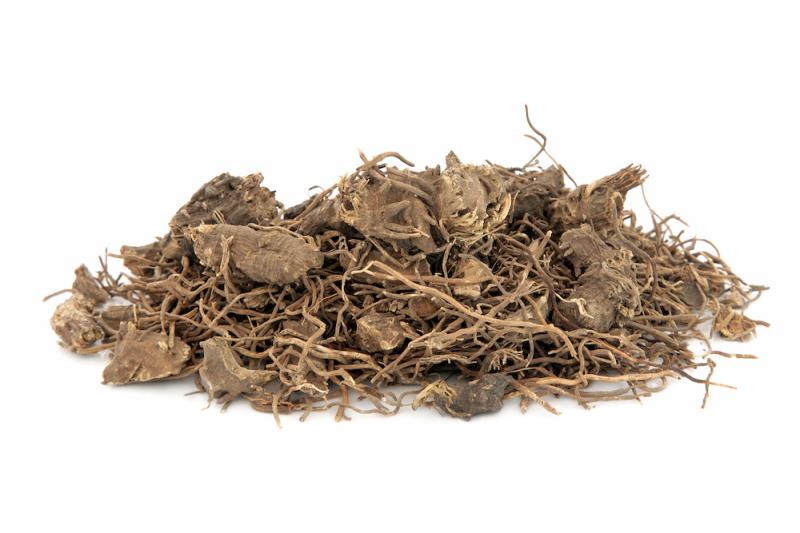 A native of the Eastern United States woodlands, black cohosh arises from a gnarled, dark root. The entangled foliage rises up from these roots into a tall (4-8 foot) plant bearing feathery, white flowers in graceful spikes. The flowers have a puffy appearance, that remind me of clouds.
A native of the Eastern United States woodlands, black cohosh arises from a gnarled, dark root. The entangled foliage rises up from these roots into a tall (4-8 foot) plant bearing feathery, white flowers in graceful spikes. The flowers have a puffy appearance, that remind me of clouds.
These characteristics help us relate to the personality and hence, the deeper medicinal power of this plant. The gnarled, black root suggests the dark state of mind out of which black cohosh helps to lift the person. The tangled foliage represents the difficult journey of finding one’s way through the problems until one can be lifted up into the light, like the beautiful spikes of white flowers.
Black Cohosh and Depression
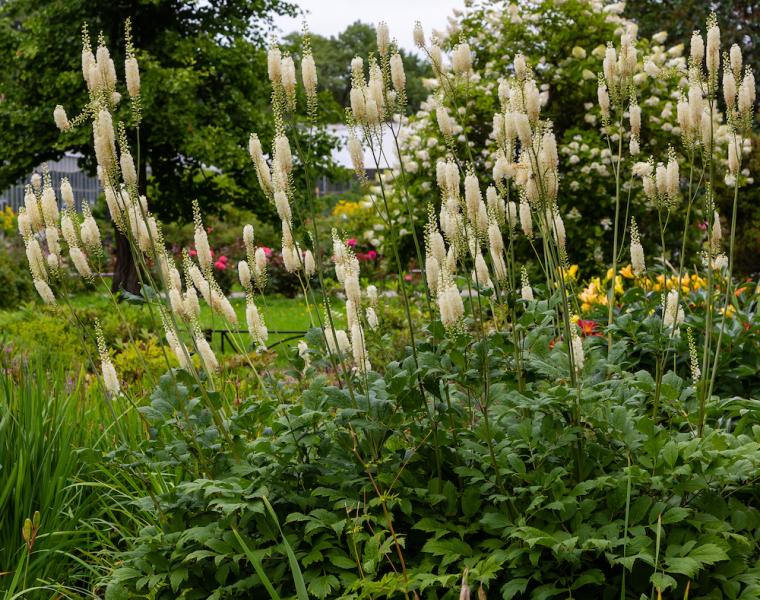 One of the less well-known uses of black cohosh is it’s use as a remedy for depression. It has been used homeopathically for people who are plagued by dark, brooding thoughts and depression. I think of the type of depression black cohosh helps lift a person out of as “black cloud” depression. As you sometimes see in cartoon images, it’s almost like there’s a black cloud hanging over the person’s head, obscuring their vision and ability to find the light. There may be a feeling of heaviness in the head and heart.
One of the less well-known uses of black cohosh is it’s use as a remedy for depression. It has been used homeopathically for people who are plagued by dark, brooding thoughts and depression. I think of the type of depression black cohosh helps lift a person out of as “black cloud” depression. As you sometimes see in cartoon images, it’s almost like there’s a black cloud hanging over the person’s head, obscuring their vision and ability to find the light. There may be a feeling of heaviness in the head and heart.
This depression is also characterized by a feeling of being trapped. This is one of the indications for the flower essence; the person feels trapped in an abusive or addictive situation. They may feel like they are hopelessly entangled in this dark situation, like the tangled roots of the black cohosh plant, and see no way to escape from it.
In Seven Herbs: Plants as Teachers, Matthew Wood says the plant is particularly helpful for women who have magnetic personalities with intense, dark, flashing, deep eyes. These attractive women find themselves drawn into relationships with possessive, jealous, and abusive men and wind up feeling trapped and unable to escape. This lends itself to physical problems with their female cycle, such as severe PMS symptoms or cramps, or even delayed or absent periods.
Other specific female indications for black cohosh include depression associated with PMS or menopause, postpartum depression, women who fear death during pregnancy or childbirth, and women who alternate between brooding, dark, depressed states of mind and manic, hysterical, overly excited, and talkative states.
Black Cohosh Flower Essence
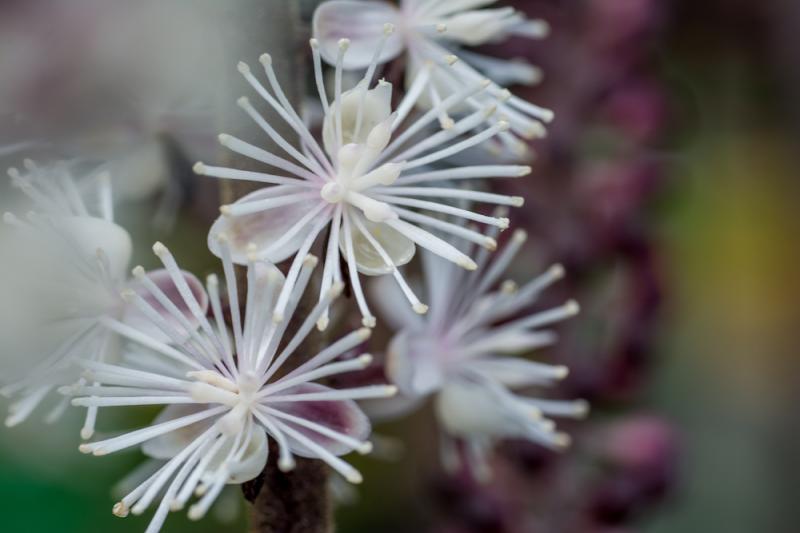 Black cohosh flower essence helps someone find their way out of the darkness. The depression they feel is often due to failure in love or finances. As a result of these setbacks, they feel like they are wrestling with dark forces. They feel like there is no escape as they are hopelessly entangled in this dark situation. The flower essence lifts them out of the tangled roots of their problems, through the complex tangled foliage or life circumstances that arises from them, and into the light associated with the beautiful white flowers.
Black cohosh flower essence helps someone find their way out of the darkness. The depression they feel is often due to failure in love or finances. As a result of these setbacks, they feel like they are wrestling with dark forces. They feel like there is no escape as they are hopelessly entangled in this dark situation. The flower essence lifts them out of the tangled roots of their problems, through the complex tangled foliage or life circumstances that arises from them, and into the light associated with the beautiful white flowers.
Black cohosh can help both men and women who feel trapped in dark situations. I once found myself in such a state. I felt I was in a hopelessly dark and abusive situation and felt like there was no way out. I started taking black cohosh flower essence and within two or three days my mind cleared and I saw that there was a way out of this situation and began taking steps to correct it.
Black Cohosh as an Antispasmodic
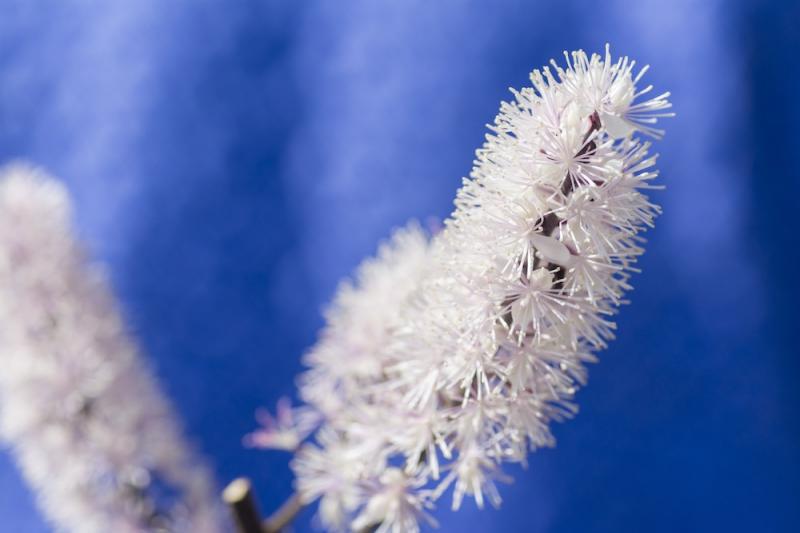 One of the strongest characteristics of black cohosh is its antispasmodic action. Antispasmodics relax muscle cramps and spasms throughout the body, which is related to the ability of black cohosh to unwind or untangle situations. So, it opens one up to move freely again both emotionally and physically.
One of the strongest characteristics of black cohosh is its antispasmodic action. Antispasmodics relax muscle cramps and spasms throughout the body, which is related to the ability of black cohosh to unwind or untangle situations. So, it opens one up to move freely again both emotionally and physically.
This relates to one of its common uses for women. It eases menstrual cramps and can also ease pain during childbirth. However, the antispasmodic action of black cohosh has been used in the past for many other situations for which it is seldom used today. Like lobelia, it can be used to relax bronchial spasms to ease asthma and whooping cough.
Black cohosh also dilates blood vessels to reduce blood pressure. Because of this, it can help relieve vasoconstrictive or tension headaches. These types of headaches occur when muscle tension inhibits blood flow to the brain giving a tight constricted feeling in the head like it’s being squeezed by a belt or a vise. Importantly though, this also means that if too much black cohosh is taken when you don't have a vasoconstrictive headache it can relax the blood vessels going to the head enough to cause a vasodilative headache. This type of headache is caused by excessive blood flow in the head and is characterized by a throbbing, pounding feeling in the head, like it’s trying to explode.
Black Cohosh as an Analgesic
Another major property of black cohosh is its anodyne (pain-relieving) action. The plant contains salicylates (the natural form of aspirin found in plants like white willow, meadowsweet, and wintergreen). It contains anemonin, an anti-inflammatory compound that can also reduce pain. It has been traditionally used to ease ovarian, uterine, and breast pain, as well as painful contractions during childbirth. It has also been used for neuralgia, rheumatoid and osteoarthritis, and muscle pain.
Matthew Wood has also successfully used homeopathic black cohosh for whiplash. He noted that tall flower stalks are whipped by the wind, a possible signature for its use as a whiplash remedy, and that the whiplash patient often feels trapped and encircled, an emotional indication for black cohosh. You can also try using the flower essence or single-drop doses of the tincture for this.
Antivenomous Remedy
In both America and China black cohosh was considered a remedy for rattlesnake poison. It appears to be able to counteract venom in general. Years ago, Don Lubecke of Arizona told me about how he used six capsules of black cohosh and 6,000 mg. of vitamin C after a black widow bite. He indicated this treatment was highly effective.
Interestingly enough, black cohosh gets its Latin name (Cimicifuga racemosa) from its properties as a bug repellant. Cimicifuga comes from cimex (a bug) and fugo (to drive away). Its rank smell was used to drive insects away, which gave it the common names of bugwort and bugbane.
Black Cohosh as a Female Tonic
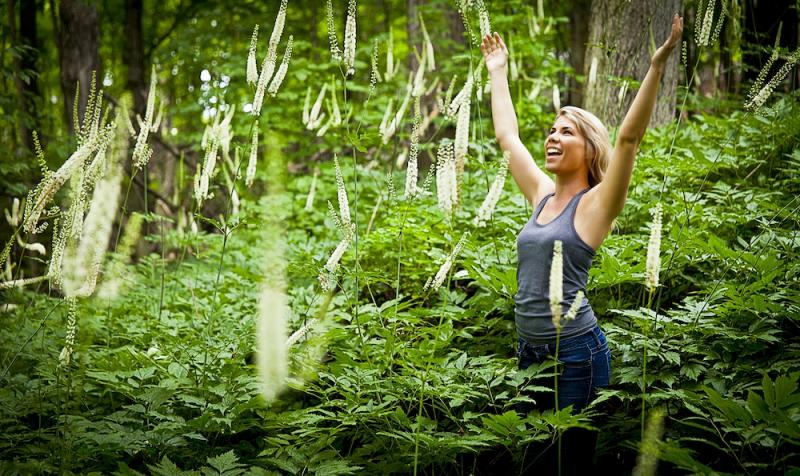 Black cohosh has been traditionally used for situations where there is a deficiency of estrogen, such as PMS type D and menopause. PMS Type D is characterized by higher levels of progesterone and lower levels of estrogen, and typically creates heavy feelings of sadness and depression right before the period, rather than the anger and irritability commonly seen in PMS type A. PMS Type D is the less common form, but black cohosh is very helpful for women who have it.
Black cohosh has been traditionally used for situations where there is a deficiency of estrogen, such as PMS type D and menopause. PMS Type D is characterized by higher levels of progesterone and lower levels of estrogen, and typically creates heavy feelings of sadness and depression right before the period, rather than the anger and irritability commonly seen in PMS type A. PMS Type D is the less common form, but black cohosh is very helpful for women who have it.
It's also a classic remedy for aiding women through menopause as estrogen production declines in their bodies when periods cease. Black cohosh eases many symptoms of menopause, including hot flashes, night sweats, skin crawling, depression, and loss of sex drive.
We don’t know for sure why black cohosh works in these situations as it is not directly estrogenic, that is, it doesn’t contain phytoestrogenic compounds that mimic the action of estrogen. It is effective, nevertheless.
Using Black Cohosh
Black cohosh can be used herbally (where physical symptoms and emotional symptoms match) or energetically both as a flower essence and a standard single homeopathic. When using the herb, small doses are usually called for as an overdose can cause headache, dizziness, visual disturbances, a slow pulse rate, nausea, and even vomiting. For this reason, it is best to start with smaller doses. Taking it as a single herb in a tincture or extract is the best way to regulate the dose. Start with 5-10 drops and increase the dose if you tolerate it well. If you need to take it in a capsule do it as part of a formula as even one capsule may be too much for many people.
Steven's Articles
October
-

-
Understanding Caffeine & Cellular Adaptation
Preserving the power of caffeine's buzz and the…
September
-

-
Horseradish
A pungent spice for aiding protein metabolism…
-

-
Banaba or Crepe Myrtle
A beautiful tree from Southeast Asia whose leaves…
August
-

-
Monkeyflowers
Flower essences to help see ourselves more clearly…
-

-
Mariposa Lilies
Strengthening the bond between mother and child…
-

-
The Noble Bay Leaf
A common kitchen herb for aiding digestion and…
-

-
Epimedium: Horny Goat Weed
A circulatory stimulant and kidney yang tonic…
July
-

-
The Medicinal and Nutritional Benefits of Apricots
A nutritious fruit and valuable medicinal seed for coughs
-

-
Dogwoods
Asian dogwood is used to stop excessive discharge,…
June
-

-
Neem: The Village Pharmacy
A popular Ayurvedic remedy for dental and immune…
-

-
Spilanthes: The Toothache Plant
A traditional remedy for teeth and gums, as well…
-

-
Forsythia
An anti-inflammatory, fever-reducing, and infection fighting herb
May
-

-
Buckwheat (Kashi)
A delicious, high protein, gluten-free, gut-healthy food
-

-
Leaky Gut Syndrome
Plugging the leaks on the underlying cause of…
-

-
Storksbill
An edible, medicinal, weedy herb, helpful for…

